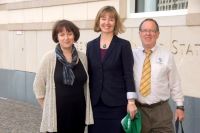 We started the day at one of the best views in Berlin—at the US Embassy in sight of the Brandenburg Gate. Our ticket there was Karin Churchey, a 1993 graduate of IWU who earned a MA in International Economics and Politics from the Johns Hopkins University; her career shifted from State Farm to State Department and found her in the political section of the Embassy in Berlin. She was kind enough to invite four of her colleagues to explain the structure and work of the Embassy, and in turn,
We started the day at one of the best views in Berlin—at the US Embassy in sight of the Brandenburg Gate. Our ticket there was Karin Churchey, a 1993 graduate of IWU who earned a MA in International Economics and Politics from the Johns Hopkins University; her career shifted from State Farm to State Department and found her in the political section of the Embassy in Berlin. She was kind enough to invite four of her colleagues to explain the structure and work of the Embassy, and in turn,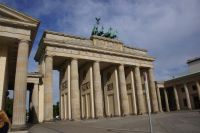 they gave us a quasi-official view of current issues in the European Union. By and large, they were pleased to be posted in Berlin and rather optimistic about the European Union and Germany’s place in it.
they gave us a quasi-official view of current issues in the European Union. By and large, they were pleased to be posted in Berlin and rather optimistic about the European Union and Germany’s place in it.
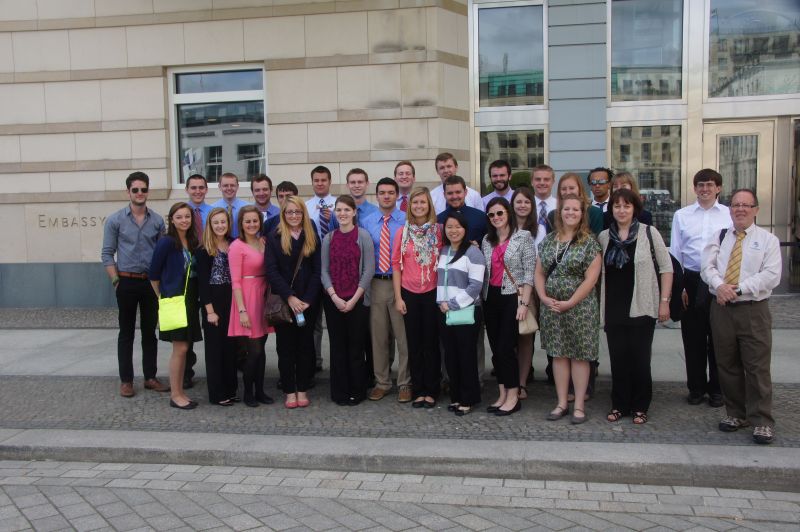 The political and economic officers, for example, mentioned that Germany has asserted leadership, both within the European Union and also on behalf of the European Union in world politics—it’s got a number of troops supporting US efforts in the Middle East, for example. German support for the government’s handling of the economy registers in the 70%, while Europe as a whole averages under 10. Even the support of Germans for the efforts to prop up the Euro are applauded—provided the mechanisms for responsibility and accountability are put in place. Germans do not generally accept debt as readily as Americans do—the German word for guilt is identical to the word for debt, he stated, and was one reason Germany did not get burned as badly as the US did in 2008; another is that the economy is still weighted toward industry, rather than services. He also pointed out that Germany has become a bigger economic trading partner with the Chinese, something I’ve seen on my trips to China. Germany has benefitted from both travel (2 million Germans get US visas; 1 million Americans reciprocate), and, with the lowest birth rate in Europe, from immigration; 20% of Germans are “first generation.”
The political and economic officers, for example, mentioned that Germany has asserted leadership, both within the European Union and also on behalf of the European Union in world politics—it’s got a number of troops supporting US efforts in the Middle East, for example. German support for the government’s handling of the economy registers in the 70%, while Europe as a whole averages under 10. Even the support of Germans for the efforts to prop up the Euro are applauded—provided the mechanisms for responsibility and accountability are put in place. Germans do not generally accept debt as readily as Americans do—the German word for guilt is identical to the word for debt, he stated, and was one reason Germany did not get burned as badly as the US did in 2008; another is that the economy is still weighted toward industry, rather than services. He also pointed out that Germany has become a bigger economic trading partner with the Chinese, something I’ve seen on my trips to China. Germany has benefitted from both travel (2 million Germans get US visas; 1 million Americans reciprocate), and, with the lowest birth rate in Europe, from immigration; 20% of Germans are “first generation.”
There’s no doubt that Germany “runs the economic show” in Europe, too, and has become an economic as well as a political force. One of the officers began by mentioning a number of US cities, including Spartanburg, S.C., which were home to German auto transplants.
The State Department folks mentioned internships, and I think one thing our students are discovering is ways to return to Europe and to become better positioned to work in Europe.

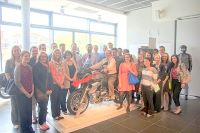 Our more traditional business visit was to a BMW motorcycle plant—the only manufacturing one in the world, which is in Berlin. That provided a fascinating look at a German company that is global, and one that demonstrates the industrial competitive advantage of Germany. BMW has been manufacturing motorcycles since 1923, and despite the cost (the cheapest one, I thought he said, was 7000 Euro, or about $10,000; the top-of-the line is $23,000 but it can go up to 310 Km an hour—that’s about 180 miles an hour! ), has a 25% market share in Germany, with about 80% of the 110,000 cycles exported. Some of them are assembled elsewhere, especially in Brazil. When I asked about outsourcing, the tour guide said some subassembly is done in Austria. The bikes are all presold, and you can design any way you like (that’s why the bikes are top-of-the line. You can make it in 46 colors).
Our more traditional business visit was to a BMW motorcycle plant—the only manufacturing one in the world, which is in Berlin. That provided a fascinating look at a German company that is global, and one that demonstrates the industrial competitive advantage of Germany. BMW has been manufacturing motorcycles since 1923, and despite the cost (the cheapest one, I thought he said, was 7000 Euro, or about $10,000; the top-of-the line is $23,000 but it can go up to 310 Km an hour—that’s about 180 miles an hour! ), has a 25% market share in Germany, with about 80% of the 110,000 cycles exported. Some of them are assembled elsewhere, especially in Brazil. When I asked about outsourcing, the tour guide said some subassembly is done in Austria. The bikes are all presold, and you can design any way you like (that’s why the bikes are top-of-the line. You can make it in 46 colors).
The guide told the story of a Middle Eastern sheik who asked whether BMW could make a gold motorcycle. When asked what he wanted to pay for it, he replied, “No limit.” The plant shut down all production to make the car for him. The factory has 100% quality check, too, which, as I said, provided an impressive case study of German competitiveness in manufacturing.
The rest of the afternoon was on our own, and Professor Pana and I came back to the Museum Island, where there are five major museums, for a stab 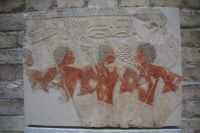 at another. One of the highlights of the collections here is a colorful bust of Nefertiti, discovered by one of those German archaeologists I mentioned yesterday in December 1912. Consequently, the museum (ironically, it was in the “New” Museum; the “Old” Museum has Renaissance and later painting!) had a special exhibit celebrating 100 years of the bust, which featured the workshop it was found in—it was involved in the Akhneton period, when Egypt turned to the Sun God; I think his son was King Tut, probably the best known non-Biblical pharaoh. I’m glad the Greeks (there was an interesting exhibit on the Greek/Roman world, down through the middle ages, which included materials on the Germanic tribes) et al., had so much art; there’s extensive collections around the world, but there’s still impressive collections that we’ll see beginning tomorrow in Athens.
at another. One of the highlights of the collections here is a colorful bust of Nefertiti, discovered by one of those German archaeologists I mentioned yesterday in December 1912. Consequently, the museum (ironically, it was in the “New” Museum; the “Old” Museum has Renaissance and later painting!) had a special exhibit celebrating 100 years of the bust, which featured the workshop it was found in—it was involved in the Akhneton period, when Egypt turned to the Sun God; I think his son was King Tut, probably the best known non-Biblical pharaoh. I’m glad the Greeks (there was an interesting exhibit on the Greek/Roman world, down through the middle ages, which included materials on the Germanic tribes) et al., had so much art; there’s extensive collections around the world, but there’s still impressive collections that we’ll see beginning tomorrow in Athens.
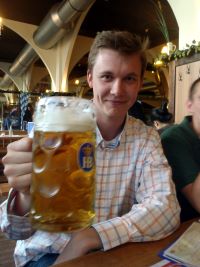
I wish Ms. Churchey had been able to join us for dinner; the German government had invited her to a Spargel meal (that’s the white asparagus that’s in season here, and a real delicacy, as I discovered the other night), and she begged off. She did recommend the Hofbrauhaus, which is around the corner for us, so we celebrated our last night in Berlin with pig knuckles and other delicacies.
We leave at 6 am tomorrow for Athens, the far reaches of the European Union. Better pack up and click off. Goodnight from Berlin.